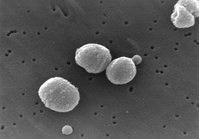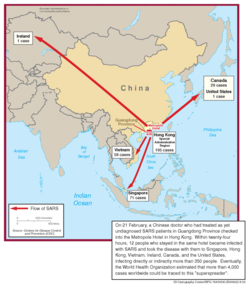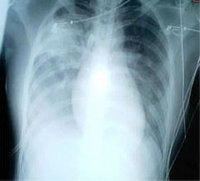Severe acute respiratory syndrome
Severe acute respiratory syndrome, better known by its acronym SARS, is an atypical form of pneumonia. It first appeared in November 2002 in Guangdong Province of the People's Republic of China. SARS is now known to be caused by the SARS coronavirus (SARS-CoV), a novel coronavirus. SARS has a mortality rate of around 10 percent. more...
After the People's Republic of China suppressed news of the outbreak both internally and abroad, the disease spread rapidly, reaching neighbouring Hong Kong and Vietnam in late February 2003, and then to other countries via international travellers. The last case in this outbreak occurred in June 2003. There were a total of 8437 cases of disease, with 813 deaths.
In May 2005, the New York Times reported that "not a single case of severe acute respiratory syndrome has been reported this year or in late 2004. It is the first winter without a case since the initial outbreak in late 2002. In addition, the epidemic strain of SARS that caused at least 813 deaths worldwide by June of 2003 has not been seen outside a laboratory since then."
For a timeline of the SARS outbreak, see Progress of the SARS outbreak.
Outbreak in the People's Republic of China
The virus appears to have originated in Guangdong province in November 2002, and despite taking some action to control the epidemic, the People's Republic of China did not inform the World Health Organisation (WHO) of the outbreak until February 2003, restricting coverage of the epidemic in order to preserve face and public confidence. This lack of openness caused the PRC to take the blame for delaying the international effort against the epidemic. The PRC has since officially apologized for early slowness in dealing with the SARS epidemic.
In early April, there appeared to be a change in official policy when SARS began to receive a much greater prominence in the official media. However, it was also in early April that accusations emerged regarding the undercounting of cases in Beijing military hospitals. After intense pressure, PRC officials allowed international officials to investigate the situation there. This has revealed problems plaguing the aging mainland Chinese healthcare system, including increasing decentralization, red tape, and inadequate communication.
In late April, revelations occurred as the PRC government admitted to underreporting the number of cases due to the problems inherent in the healthcare system. Dr. Jiang Yanyong exposed the coverup that was occurring in China, at great personal risk. He reported that there were more SARS patients in his hospital alone than were being reported in all of China. A number of PRC officials were fired from their posts, including the health minister and mayor of Beijing, and systems were set up to improve reporting and control in the SARS crisis. Since then, the PRC has taken a much more active and transparent role in combatting the SARS epidemic.
Spread to other countries
The epidemic reached public spotlight in February 2003, when an American businessman travelling from China came down with pneumonia-like symptoms while on a flight to Singapore. The plane had to stop at Hanoi, Vietnam, where the victim died in a hospital. Several of the doctors and nurses who had attempted to treat him soon came down with the same disease despite basic hospital procedures. Several of them died. The virulence of the symptoms and the infection of hospital staff alarmed global health authorities fearful of another emergent pneumonia epidemic. On March 12, 2003, the WHO issued a global alert, followed by a health alert by the United States Centers for Disease Control and Prevention (CDC).
Read more at Wikipedia.org




